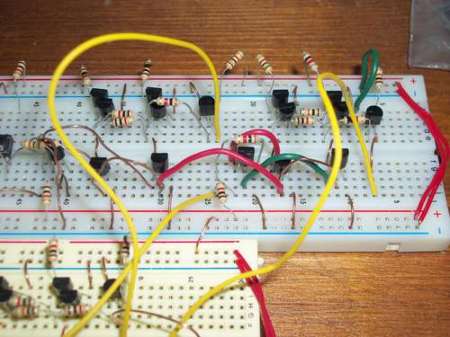
If you’ve ever wanted to dive in and take a look at how memory hardware is implemented here is a good example of how to implement some latching circuits with ether BJT or CMOS transistors. BJTs require biasing resistors which increases the complexity and power consumption when compared to CMOS. If power consumption isn’t an issue you could certainly make some really fast logic.
Most modern on chip RAM is made using SRAM because it only takes six transistors to implement(vs eight) and is pretty fast. When it comes to density DRAM can get one bit of storage by using a single transistor and capacitor(putting the capacitor underneath he transistor can save even more space). All that said, latches and flip flops are still a very useful (and common) tool when working with digital circuits.
















pretty cool, i remember building transistor based memory on the S-Dec (an early prototyping board)
you can also make shift registers this way, single transistor per stage and can clock in data at the speed of the astable stages.
I remember back to my first electronics course at uni, the lecturer told us that there’d be a trick question in the final exam: “Draw a CMOS transistor”. Every year at least a few people would try to do it.
@zeropointmodule Stargate!!!!!!!!
Anyways while it would be cool to build ram hacking preexisting hardware is funner
Interesting project but where’s the schematic?
I really love these hacks — it’s a way to connect “stuff I can build on a breadboard” with “stuff I use every day at work”. Too many people think consumer products = magic.
“stone knives and bearskins”
/oblig
Geoff T, My digital lecturer did that too, also draw a biCMOS transistor :)
Tom, I guess you have to click on the links that lead to the Wikipedia site for a schematic.
We just covered this in class last week, and I busted out the breadboard to try it. Perfect Timing.
This reminds me of the first “computer” I built in high school – it would add two numbers (set by toggle switches) in .001 second. One of the teachers asked whatever use something like that would be….
If we know what “CMOS” stands for, what the hell is a “CMOS transistor”???
Do we know what we are talking about, or just shooting from the lip?
Very interesting stuff for those who are learning digital electronics. Unfortunately it got ruined by Instructables which is among the worst places one should use. Please, stop posting stuff over there.
Agreed, Instructables is a terrible web interface.
@qwerty and smoker_dave:
Can any of you suggest a good alternative to Instructables?
@godi:
1. pick a free webhoster of your choice
2. pick an editor of your choice
3. write a webpage about the hack you did
4. upload it to the webhoster of step 1
5. spread the address
6. ???
7. profit!
Any free blog site would be preferable to Instructables :(
Anyway, cool project :) It’s always fun to implement such common circuits in a way which makes it less abstract, akin to those people building 8-bit CPUs out of 74xx logic chips.
@Geoff T and Richard, I’m kind of an electronics newbie, is there something to the joke about drawing CMOS Transistors? I’m missing the “trick” to the question.
i’m no expert, used to play with this stuff as a kid almost 20 years ago. afaik theres no such thing as a single CMOS transistor, as anything CMOS will be something made up of multiple MOS transistors. atleast thats the way i remember reading it anyway.
The C in CMOS stands for complimentary. CMOS uses both P and N type transistors (MOSFETs) together. Therefore you can’t draw a CMOS transistor because CMOS is composed of multiple transistors. “Draw a CMOS transistor” is akin to saying draw a water atom.
Err, complementary not complimentary. Although 74HC00s are known for their shameless flattery.
Thank’s pfargtl and jethomson, I think I get it. It is similar to a “Darlington transistor” in that it is two parts but one device. Like pants. Though I don’t think “Draw pants” would be a trick question.
Hey what is the input voltage on this circuit?